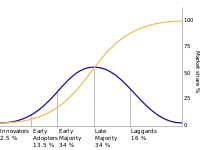
Photo from wikipedia
BACKGROUND Neuroplastic processes are influenced by serotonergic agents, which reportedly alter white matter microstructure in humans in conjunction with learning. The goal of this double-blind placebo-controlled imaging study was to… Click to show full abstract
BACKGROUND Neuroplastic processes are influenced by serotonergic agents, which reportedly alter white matter microstructure in humans in conjunction with learning. The goal of this double-blind placebo-controlled imaging study was to investigate the neuroplastic properties of escitalopram and of cognitive training on white matter plasticity during (re)learning as a model for antidepressant treatment and environmental factors. METHODS Seventy-one healthy individuals (age=25.6±5.0, 43 females) underwent three diffusion magnetic resonance imaging scans: at baseline, after 3 weeks of associative learning (emotional/non-emotional content), and after relearning shuffled associations for an additional 3 weeks. During the relearning phase, participants received a daily dose of 10 mg escitalopram or placebo orally. Fractional anisotropy (FA), and mean (MD), axial (AD), and radial diffusivity (RD) were calculated within the FMRIB software library and analyzed using tract-based spatial statistics. RESULTS In a three-way repeated-measures marginal model with sandwich estimator standard errors, we found no significant effects of escitalopram and content on AD, FA, MD, and RD during both learning and relearning periods (pFDR>0.05). When testing for escitalopram or content effects separately, we also demonstrated no significant findings (pFDR>0.05) for any of the diffusion tensor imaging metrics. LIMITATIONS The intensity of the study interventions might have been too brief to induce detectable white matter changes. DISCUSSION Previous studies examining the effects of SSRIs on white matter tracts in humans have yielded inconclusive outcomes. Our results indicate that relearning under escitalopram does not affect the white matter microstructures in healthy individuals when administered for three weeks.
Journal Title: Journal of affective disorders
Year Published: 2022
Link to full text (if available)
Share on Social Media: Sign Up to like & get
recommendations!